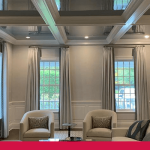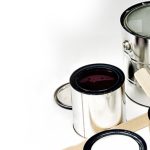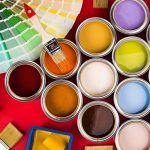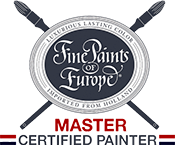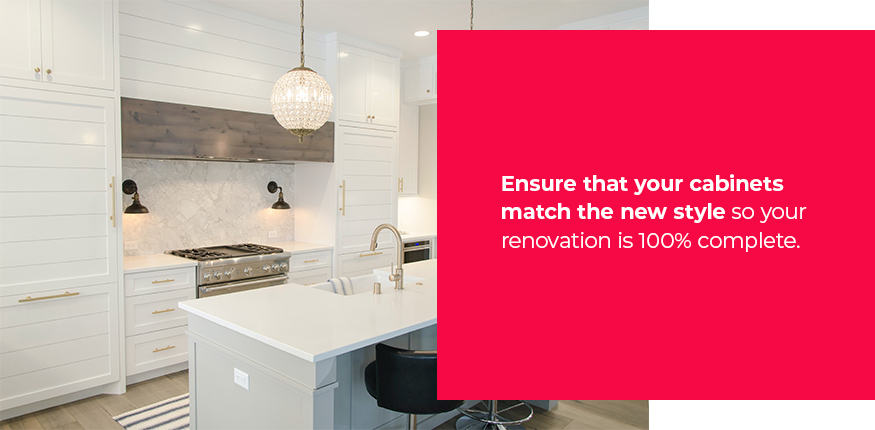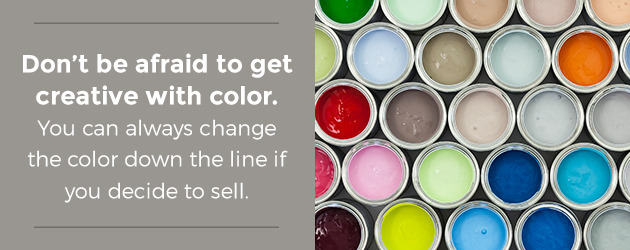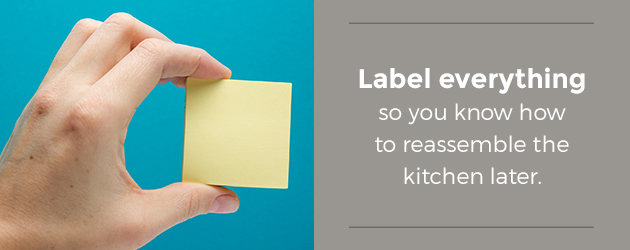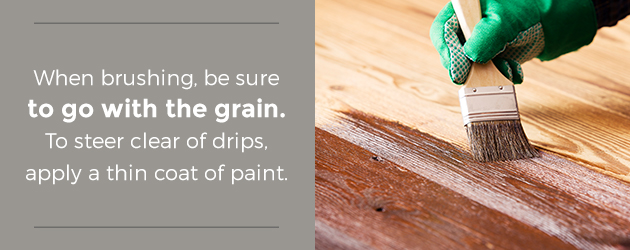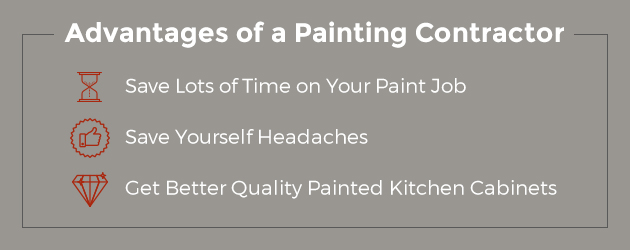What to Consider When Having Your Kitchen Cabinets Repainted
September 25, 2024
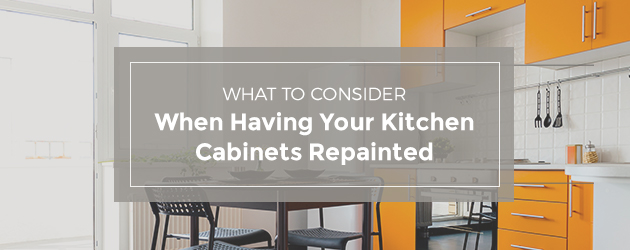
Jump to:
- How Are Cabinets Refinished?
- Reasons to Refinish Your Cabinets
- Consider the Cabinet Finish
- Decide What Color to Paint Your Cabinets
- Get Creative With Your Cabinet Color
- Should You Use Spray Paint or a Brush to Paint Your Cabinets?
- How to Paint Your Kitchen Cabinets
- Painting Your Kitchen Cabinets
- Tips for Painting Kitchen Cabinets
- Advantages of Hiring a Painting Contractor
Kitchen remodeling is one of the most expensive and complex projects homeowners can undertake. A significant portion of this cost is kitchen cabinets. New cabinetry and installation require a substantial budget. In fact, they typically make up nearly 50 percent of the total kitchen remodeling budget. Fortunately, alternatives are available to reduce the cost of kitchen remodeling and still achieve a fresh, new look for your space. Rather than replace all the cabinetry, consider repainting your kitchen cabinets.
You might be surprised what an affordable fresh coat of paint can do for your kitchen. You can revive dark, outdated cabinets and create a bright and airy kitchen fit for a magazine cover. To achieve this transformation, homeowners must consider several factors and complete several steps.
How Are Cabinets Refinished?
Before you decide to have your cabinets refinished, you may want to understand more about the cabinet refinishing process.
At Shoreline Painting, our experts can make kitchen cabinets look brand new with our attention to detail and care for our craft. We will begin by removing any old hardware, such as handles and hinges. Then we remove the old finish on the cabinets before refinishing or repainting them.
If you choose to keep the original hardware, our refinishing experts can polish or paint them to bring out the individual character of the pieces. If you want new hardware, our dedicated team of experts will work with you to find a new look and style to meet your preferences.
Additionally, our team of experts will work closely with you to determine a color choice, finish and texture that you would like for your cabinets. With Shoreline Painting, the possibilities for your cabinets’ refinishing are nearly endless!
Reasons to Refinish Your Cabinets
If you aren’t quite sure if you should get your cabinets refinished yet, consider the following five signs that it may be time to give your cabinets an update.
1. Cabinet Doors Are Not Functioning Properly
It’s inconvenient and annoying when a cabinet door isn’t functioning properly. A door that won’t fully close or open or hangs unevenly on its hinges can be a hassle to work around and an eyesore to look at. Cabinet doors that are sagging, jammed, or misaligned are often an indication that it’s time to refinish your cabinets.
Refinishing your cabinets allows the doors’ mechanics such as handles and hinges to be repaired or replaced. A refinishing expert at Shoreline Painting will ensure that all your cabinet drawers and doors are level and aligned perfectly upon reinstallation.
2. Style Does Not Match a Recent Renovation
The average American household remodels its kitchen every 10 to 15 years. To ensure your cabinets fully match the rest of your kitchen after a remodel, you may need to update your cabinets as well. Cabinets are one of the first things that you see when you enter your kitchen. If you have recently renovated the rest of your kitchen, ensure that your cabinets match the new style so your renovation is 100% complete.
3. Cabinets Have Minor Damage
Minor nicks, scrapes and scratches to the exterior of your cabinets are sometimes unavoidable. Because cabinets are used daily, they often receive small amounts of damage. A professional cabinet refinisher such as Shoreline Painting can fix cabinet paint damage and return them to like-new condition.
If your cabinets have minor damage such as peeling, discolored or faded paint or light scratches, refinishing your cabinets is a better and more cost-effective way to restore your cabinets. You can often refinish cabinets with moderate damage such as deep scratches, gouges and dents, especially if you plan to paint them.
4. Cabinets Are Still in Good Condition
While many people see cabinets that still work properly and are in good condition as the opposite of a candidate for refinishing, that couldn’t be further from the truth. If you have older cabinets that still operate effectively and have little to no damage, they are perfect for refinishing.
If your cabinets are broken and have extensive wear and tear, you may need to replace them completely due to the extent of their damage. However, if your cabinets work properly but are simply outdated, you can easily and efficiently get them refinished.
5. Room Layout Is Functional
When installing brand new cabinets, it can be difficult to keep your kitchen in the same layout that it was in previously. Newer cabinets may not be the same size, shape, and measurements as those you previously had.
If you like the measurement and size of your current cabinets and the layout of your room is functional, consider simply updating and refinishing your cabinets instead of tearing them out and replacing them with new cabinets. Refinishing or repainting is easier, more economical and more efficient, and it maintains the overall space and functionality of your room.
Consider the Cabinet Finish
The finishes of your cabinets and your paint are key. First, you must determine if your cabinets offer a finish that can be painted. What are they made of? Wood, metal and wood veneers are ideal for repainting kitchen cabinets. If your cabinets are made of laminate or melamine, you can try to repaint them, but it will be difficult, and you may not be happy with the results.
If you determine your cabinets are acceptable for repainting, you must next choose the appropriate paint finish for the job. Many pros recommend using an oil-based paint. This creates a harder surface when it cures, which is preferable for the busy, messy space most kitchens become.
The challenge with this option is the difficulty in working with oil-based paints. Oils offer an unpleasant aroma and require longer drying times. As an alternative, a latex satin finish works well on kitchen cabinets and is easier to work with than oil paints.
The main concept to keep in mind is to create a surface that is durable and wipeable. You don’t want to repaint again for a few years, so develop a finish that will last. Matte paint won’t cut it. Choose satin, semi-gloss or gloss. The harder the finish, the better.
Decide What Color to Paint Your Cabinets
An essential step in repainting your kitchen cabinets is choosing the best color. As you review your options, keep in mind the overall style you want to achieve for your space. Use the following tips for the best results:
Find inspiration: Draw inspiration from something in the room. It’s easier to find a paint color to match an existing accessory, fixture or furniture than the other way around. If you already know the colors of your walls, counters or other pieces of your kitchen, start there.
Use samples: Bring paint chips home from the store. Any hardware store offers paint sample cards you can pick up to examine in your kitchen. Grab a variety of color samples in shades you are considering and place them around your kitchen. See what looks best to help you decide on a final choice.
Choose quality paint: As you gather samples and select your paint color, be sure to use high-quality paint. You’re already saving money by repainting your kitchen cabinets rather than replacing them. Go ahead and spend a little extra to get a good product. It will make a world of difference in the final outcome of your repainting project.
Get Creative With Your Cabinet Color
Don’t be afraid to think outside the box. Many homeowners fear personalizing their kitchen. Thoughts of resale value and keeping things neutral cloud their creativity.
Keep in mind, you’re the one who has to live there. Unless you are prepping your home for immediate sale, feel free to make it a space you will enjoy rather than a design you hope someone else will like years from now. Remember, you can always change the color down the line if you decide to sell. If it is much farther down the line, it will probably be time to update and freshen your kitchen again anyway.
With this in mind, don’t be afraid to get creative with color. Choose something you like and use combinations to create attractive contrasts. A kitchen island can sport a different color than the perimeter cabinets. Upper cabinets can be a different color than lower cabinets. In fact, this complementary contrast is a popular trend that designers expect to see more of in the coming year.
Should You Use Spray Paint or a Brush to Paint Your Cabinets?
You must make one more decision regarding paint. Should you spray it on or brush it on? Both offer pros and cons:
- Spraying paint offers a cleaner, smoother look, sans brush strokes.
- Spraying requires a sprayer, which you have to rent or buy if you don’t own one.
- Spraying necessitates dust cloth covering of your kitchen or other surroundings to ensure paint does not land on unintended surfaces.
- Spraying works well if your cabinet designs include intricate patterns or raised panels or if the cabinets have a lot of nooks and crannies.
- Brushing works well for simple cabinet designs.
- Brushing is less complicated.
How to Paint Your Kitchen Cabinets
Whether you choose to brush or spray paint, the entire process to repaint your kitchen cabinets requires several steps. You’ll need a few supplies, a lot of skill and a significant chunk of time. Plan on devoting a couple of weekends to this project or taking a couple of vacation days off work to knock it out. Even if you are a fast painter, you still need to allow for drying time. When you’re ready to get started, follow these steps:
Prep Work for Painting Your Kitchen Cabinets
Before you open a single can of paint, you must complete the necessary prep work to ensure your cabinets are ready to receive it. Taking the time to properly prep your kitchen cabinets will make the difference between a smooth project with impeccable results and a difficult process with a less-than-satisfactory outcome. It’s understandable to want to jump right into the painting portion, but it’s worth performing the prep work first.
Disassemble Your Kitchen
Take out all items from inside your cabinets and drawers. Then, remove all the cabinet doors and drawers. Take off handles, knobs and hinges. Label everything so you know how to reassemble the kitchen later. Even if they seem the same, drawers and doors might not fit properly in a different place due to settling and shifting since construction was completed. A simple way to do this is to flag each piece of cabinetry with numbered pieces of painter’s or masking tape.
The same goes for hardware. Label everything and store it in a safe place until your project is complete. If you plan to install new hardware that is a different size or shape, your prep work includes filling in the holes where the old hardware was installed.
Protect Your Kitchen
Cover your countertop to prevent paint splatters and spills from damaging the surface. Use rosin paper and painter’s tape. To protect your backsplash, use plastic.
Clean Your Kitchen Cabinets
Do not try to paint over years of splatters, grease, fingerprints and grime. The new paint will not stick to surfaces coated with these particles. Remove it with a degreaser. Then, wipe everything down with a cleanser, using a sponge. Clean every inch of doors, drawer fronts, cabinet frames and anything you intend to paint.
Smooth Your Kitchen Cabinets
If your cabinets are like most, they have a few imperfections. Fill in any dings with wood putty. As mentioned, if you plan to change hardware, fill hardware holes as well.
Sand Your Kitchen Cabinets
Once everything is cleaned and filled, sand down the surfaces to ensure the paint can stick. Use 100-grit sandpaper for effective results. Sand along with the grain. You may want to take the cabinet faces to the garage to do this to cut down on mess.
Clean Your Kitchen Again
After you’ve completed the sanding, wipe everything down to remove all sawdust. A damp cloth and a vacuum work well. Tack cloths are another helpful tool. You can find these in the paint aisle at your hardware store. These sticky cloths are great to wipe over the surfaces to pick up dust and sanding grit. Unfold the cloth, cut a section off, use it to wipe down the cabinets, and throw each piece away once it loses its stickiness or gets dirty.
Prime Your Kitchen Cabinets
It may seem your kitchen is ready for painting now, but you must complete this last prep-work step for the best results. Once it is sanded and recleaned, your kitchen is ready for primer. Oil-based primer works best due to its durability and adhesiveness.
Start with the corners and edges of your cabinets and work around the trim. Use a four-inch roller to finish off the remainder. If you prefer brushing, a 2.5-inch paintbrush works well. Brush against the grain, then with the grain. Be sure to allow the primer to dry, then flip your pieces to complete the other side. You should paint the cabinet boxes during this down time.
Let everything dry, then sand it all down with 220-grit sandpaper. Yes, you should sand between every coat. Yes, this means wiping everything down again after you finish sanding. Repeat this process for a second coat of primer. This will ensure the grain is completely filled for the best finish.
Painting Your Kitchen Cabinets
After you’ve cleaned up the sanding grit from the second coat of primer, you are ready to apply the paint. Use an angled brush and a mini foam roller to paint. Start at the back of the drawer and door fronts, brushing corners and edges, then roll the paint over the rest of the surface. When brushing, be sure to go with the grain. To steer clear of drips, apply a thin coat of paint.
Lay doors and drawers flat while they dry. Paint the frames and cabinet boxes. After the first side of the drawers and doors appear dry, turn them and complete the other sides. Once completely dry, sand all the surfaces again and wipe them clean. Then, repeat the painting process.
Some kitchen cabinet repainting projects require three coats, but you can decide after a second coat if you are happy with the results. You do not need to sand again after the final coat. If you notice any paint drips, you can remove these with a sanding block and dab with paint touch-ups to smooth it out. Fix any other touch-ups that are needed.
Congratulate yourself. You’ve finished the painting portion of your kitchen remodel.
Reassembling the Kitchen Cabinets
Allow the cabinets to cure. This will take one to two days. In humid weather, it may take longer. When the cabinetry is cured, you can begin to reassemble your kitchen. Using your helpful labels, attach hinges on the doors and put them on the cabinet boxes. Next, add the faces of the drawers. Finally, screw on hardware pulls and knobs. Re-fill your cabinets with dishes and food, then step back to take in your beautifully rejuvenated kitchen.
Tips for Painting Kitchen Cabinets
To some, this process sounds simple. To others, it may feel overwhelming. If you want to tackle this project yourself, use the following tips to make it as easy as possible.
- Buy quality supplies — Don’t buy cheap rollers and brushes. They may save you money at the hardware store register, but you’ll pay for it while painting and in the final results.
- Save clean-up time — If you need to take a break from painting or to allow dry-time between coats, wrap your rollers tightly with plastic bags. Place them in the refrigerator until needed again. Remove them about 15 minutes before you resume painting or priming. This prevents the rollers from drying out, without having to wash them out each time.
- Create a convenient workspace — If possible, use a worktable in the kitchen to paint the cabinet doors. Propping 2×4 boards on buckets or boxes makes a cheap and simple worktable if you don’t have one already.
- Use painting pyramids — These affordable props allow you to paint the second side of your cabinet doors without waiting for the first side to dry. Find them in the paint department of your hardware store.
- Substitute wood filler — Bondo, a product used for car bodywork, is a good substitute for wood filler. When repairing cracks and nicks in your cabinets, Bondo works great.
- Take your time — Most homeowners have limited time to complete remodeling projects. However, it’s important not to rush through this process. Getting it right on the first try will save time and result in a longer-lasting finish.
- Paint with proper lighting — Avoid painting under uneven lighting or poorly lit conditions. You will miss drips, and you will paint sections unevenly.
- Apply multiple coats — For best adhesion and final results, apply multiple light coats rather than one heavy one.
- Call in the pros — To truly make painting your kitchen cabinets as easy as possible, leave it to the pros. Simply call your local painting contractor to schedule an appointment. They will take it from there.
Advantages of Professional Cabinet Painting
Some projects are simple DIY tasks you can complete in an hour or two. Painting your kitchen cabinets isn’t one of them. Even if you are handy around the house and a skilled painter, you will want to hire a professional cabinet painter from Shoreline Painting for this project. Here’s why.
1. Save Lots of Time on Your Paint Job
As you can see by reviewing the process outlined above, painting kitchen cabinets requires a significant time investment. Not every homeowner has enough time to devote to this project to get it done right. If you are an inexperienced painter, the process takes even longer. Your local expert painters at Shoreline Painting will complete the job quickly and efficiently. Experienced professionals can do the work for you, while you focus on the rest of your task-list for the season.
2. Save Yourself Headaches
Unless you enjoy painting, cleaning, sanding, priming, disassembling, reassembling and project clean-up, this process may involve more than one headache. Properly painting kitchen cabinets is a meticulous process that requires skill and care. For the best results leave it to our professionals.
3. Get Better Quality Painted Kitchen Cabinets
Are you unsure about the level of skill you can bring to this job? To ensure the final results are the quality you desire, trust the project to an experienced painting contractor. They will apply in-depth knowledge and skill to produce impeccable surroundings you are sure to love.
Shoreline Painting Professional Kitchen Cabinet Painting
If you decide you’d like to leave this job to the pros, contact Shoreline Painting. Family-owned and operated, Shoreline Painting has been the premier choice for kitchen cabinet painting for residents of Fairfield County, CT, Westchester County, NY, and New York City for over 35 years. The quality of our work is unmatched by competitors. We are a Fine Paints of Europe Master Certified Painter and are fully licensed, bonded and insured. Contact us today for a free estimate.
Recent Posts & Guides
